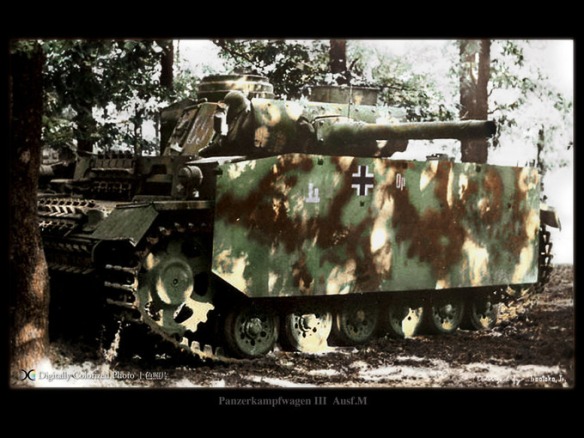
One of the 15 Panzerflammwagen issued to the 6. Panzer-Division was backfited with Schuerzen on the hull sides in May 1943.
The pump-driven flamethrower system that had al- ready been developed for the Pz. Kpfw. B2 (Fl) was mount- ed in the Pz. Kpfw. III turret. The turret could be continuously traversed through 360 degrees by installing a packing box connection on the flame oil delivery pipe. The flamethrower and coaxially mounted M.G.34 machine gun could be elevated through an arc from minus 10 to plus 20 degrees. Instead of a sighting telescope, at first the flame- thrower was roughly aimed by using an inverted “V” blade sight in front of the front vision block on the commanders cupola. This was later improved by mounting a rod with range pegs on the flamethrower armor guard, positioned directly in front of slit painted on the front vision block in the commander’s cupola. The containers inside the hull held 1020 liters of flame oil.
A range of 50 meters could be achieved with cold flame oil (60 meters when ignited) at a pressure of 15 to 17 atmospheres provided by the Koebe pump at a flowrate of 7.8 liters/second. The Koebe pump was driven by a two- stroke, 28 metric horsepower, Auto Union ZW 1101 (DKW) engine using a mixture of oil and gasoline. The flame oil was ignited using electric “Smitskerzen” (Smits’ glow plugs).
A second M.G.34 machine gun was mounted in a traversable ball mount in the superstructure front plate with an elevation arc from -10 to +20 degrees. This ball- mounted machine gun was aimed using a K.Z.F. 2 gunsight registered at a range of 200 meters. 3750 rounds of belted ammunition were carried for the machine guns in bags each containing 150 rounds of S.m.K. (armor piercing) ammunition.
A crew of three manned this 23.8 ton Flammpanzer. The commander also served as the gunner for the flamethrower and the turret mounted machine gun. A radio operator seated at the right front manned the Funkgeraet 5 radio transmitter and receiver set and also served as a gunner for the ball-mounted machine gun. The driver was located in the left front.
Armor protection was enhanced by welding 30 mm thick plates to the hull front as well as to the upper hull front. This, along with the 20 mm Vorpanzer on the superstructure front plate and gun mantle, made the Pz. Kpfw. III (Flamm) invulnerable to 75 mm armor piercing rounds fired at its front at normal combat ranges. Due to the increased threat of fire, a total of five fire extinguishers were carried, three on the inside and two on the outside.
One hundred Pz. Kpfw. III Ausf. M chassis (with Fgst. Nr. 77609 to 77708) were completed in automotive running order by the firm of Miag in Braunsweig in January and February 1943. These were delivered to Wegmann in Kassel where the flamethrowers were installed and the turrets mounted on the superstructures. The production schedule had called for 20 to be completed in January, 45 in February, and 35 in March 1943 . Following a one month delay, 65 Panzerflammwagen (Sd. Kfz. 141) were accepted by the Waffenamt inspectors in February, 34 in March, and the last one in April1943 . It was not until later that the official designation was changed to Pz. Kpfw. III (Fl) (Sd. Kfz. 141/3).